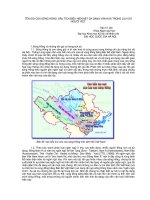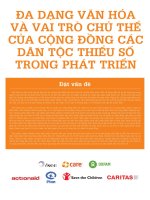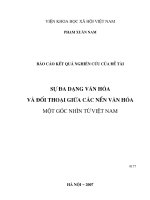Outline debate - Đa dạng văn hóa và quốc tế hóa
Bạn đang xem bản rút gọn của tài liệu. Xem và tải ngay bản đầy đủ của tài liệu tại đây (111.48 KB, 10 trang )
Khái niệm
A, "cultural diversity." This is a society - or a world -- that contains and supports many
distinct cultures, each with its own particular strengths and weaknesses, its own language
and educational system, and its own capacity to instill in its members a sense of identity
based on rootedness in their culture. Cultural diversity is the quality of diverse or different
cultures, as opposed to monoculture, the global monoculture, or a homogenization of
cultures, akin to cultural decay. The phrase cultural diversity can also refer to having different
cultures respect each other's differences
Conference of UNESCO took this position in 2001, asserting in Article 1 of the Universal
Declaration on Cultural Diversity that "...cultural diversity is as necessary for humankind as
biodiversity is for nature"
What is multiculturalism?
Cultural diversity often refers to the coexistence of many cultures, cultural forms, and
various cultural expressions in a particular region or the world in general.
What is the meaning of cultural diversity?
Cultural diversity is a characteristic of human society, so it is a necessary condition for
development, even for the survival of human beings. Cultural diversity is the origin of
identity, of innovation and creativity, which helps to connect people around the world. It
motivates development, not only economic growth, but also enriches intellectual,
emotional, moral and spiritual life.
Diverse cultural significance for the following areas:
1. Economy
Cultural diversity is a resource for many areas of the economy. Cultural and tourism
industries: create jobs and income through heritage, through visits, sales of crafts and other
cultural products.
Traditional livelihoods: preserve local knowledge, create jobs; diversified ways from
handicraft production, agriculture, resource management ...
2. Society
Cultural diversity is an effective means of promoting mutual understanding and resisting
prejudices. This is essential for social stability.
Social Inclusion: Culture is a source of hope that allows people to have a deep sense of
belonging.
Social capital: Protecting the different forms of culture and the process of forming these
forms will contribute to the strengthening of the social capital of the community and the
feeling of ownership and trust in public organizations. .
3. Security and defense
Cultural diversity is a means of promoting and securing political security as well as territorial
integrity.
Each group, ethnic group has a spiritual leader (village elders). Through spiritual leaders, cultivating
the culture and language of each group, ethnic group and locality is an effective way to ensure
political security.
Due to the characteristics of many ethnic groups living on the border and in the high mountains, the
diversity of their livelihoods and culture
Helps to protect national security, defense and territorial integrity. ethnic minority cadres have easy
access to their compatriots; Community cohesion, strengthening national unity.
4. Environment
Cultural diversity helps protect the environment. This is because each nation has its own world view.
When these cultural features are preserved, it contributes to the preservation of forests and natural
landscapes.
For example, ethnic people have a belief in sacred forests, so they must ban the strangers in the
village. This helps preserve the forest, the natural landscape.
Every region on the planet is becoming a cultural diversity and the power of diversity is being
promoted in political diplomacy, economic diplomacy and cultural diplomacy. Each culture contains
its own strengths and contributes to the development of human beings in different ways.
Dialogue between cultures enhances understanding but also provides opportunities for cultures to
cooperate, exchange and cultivate, opening new opportunities for understandable cultures. more
about the culture of the nation, its people create the premise for social development.
1 vài thành phố tiêu biểu cho đa dạng văn hóa:
1. Amsterdam
Được biết đến như một nơi chào đón người di cư và người xin tị
nạn, Amsterdam, thành phố lớn nhất Hà Lan, tự hào có một bộ phận dân cư
đa dạng. Với khoảng 178 nền văn hóa khác nhau, thành phố này là sự kết hợp
sinh động của những con người thân thiện đến từ khắp nơi trên thế giới.
Thành phố quốc tế này cũng có một bộ phận không nhỏ những người nói đa
ngôn ngữ, và đối với những người mới không biết tiếng Hà Lan, thành phố
cung cấp nhiều lớp học ngôn ngữ "hầu như miễn phí" để giúp đỡ họ.
Amsterdam cũng tổ chức nhiều sự kiện văn hóa trong suốt cả năm nhấn
mạnh tầm nhìn thế giới của họ, bao gồm Lễ hội DRONGO - lễ kỷ niệm đa
ngôn ngữ được tổ chức tại Thư viện Công cộng Amsterdam.
2. London
Là thành phố lớn nhất Vương quốc Anh, London là một trong những quần
thể đa dạng sắc tộc nhất trên thế giới. Từ Ấn Độ đến Jamaica, Ghana và
nhiều quốc gia khác, thế giới thực sự thu nhỏ trong khu vực sôi động này.
Khoảng một phần ba số người London sinh ra ở nước ngoài, và mặc dù ngôn
ngữ chính thức là tiếng Anh, những con phố này đầy sôi động với hơn 200
ngôn ngữ toàn cầu. Mặc dù nhiều người đã chọn London làm nơi sinh sống
của mình nhưng họ vẫn có tình yêu đối với nền văn hóa nơi sinh ra và chia sẻ
nó theo nhiều cách khác nhau, bao gồm các món ăn và các lễ hội như Lễ hội
Notting Hill Carnival.
3. Los Angeles
Nằm ở Nam California, Los Angeles là một trong những thành phố đa văn
hóa nhất trên thế giới với dân cư đến từ khoảng 140 quốc gia, nói 86 ngôn
ngữ khác nhau. Với luật thân thiện với người nhập cư, đây là nơi phổ biến
cho những ai tìm kiếm cuộc sống mới ở Mỹ. Los Angeles tạo ra một cảnh
văn hóa thật sự sôi động. Nơi đây đầy những khu phố có văn hóa đặc trưng
như Koreatown, Little Tokyo và Boyle Heights - một khu vực phổ biến với
cộng đồng người Latinh
4. Paris
Trong khi nhập cư là một chủ đề nóng ở Pháp, thì Paris vẫn là thành phố có
một nhóm các nền văn hóa toàn cầu khác nhau. Mặc dù rất khó để xác định
chính xác số người nước ngoài sống ở Paris vì luật pháp của Pháp cấm hỏi về
dân tộc trong cuộc Tổng điều tra, các cuộc điều tra độc lập đưa ra tỷ lệ phần
trăm từ 14% đến 20% với đa số di dân đến từ bên ngoài EU. Du khách sẽ tìm
thấy nhiều khu phố sôi động ở Paris. Ví dụ: Quartier Chinois (Khu phố Tàu)
thuộc quận thứ 13 là một cộng đồng sống động của một số nền văn hóa châu
Á trong khi Belleville (các quận 10,11,19 và 20) là một vẻ đẹp đa văn hóa
gồm các dân tộc Bắc Phi, Do Thái và Châu Á .
5. New York
Một trong những thành phố quốc tế nhất trên thế giới, New York là một đô
thị sống động nằm trên bờ biển phía Đông của Hoa Kỳ. Được tạo thành từ
năm quận, Queens là nơi đa dạng nhất với những người đến từ Ấn Độ, Hàn
Quốc và Brazil. Thân thiện với người nhập cư, NYC thành lập Văn phòng Di
dân của Thị trưởng, nơi đã tạo ra nhiều lệnh và luật pháp để giúp đỡ những
người đến từ nước ngoài – chiếm khoảng 36% dân chúng.
6. San Francisco
Một hòn đá quý đa văn hóa khác của California, San Francisco nhỏ hơn các
thành phố khác đã đề cập ở trên nhưng có nền văn hóa đa dạng không kém.
Một tỷ lệ lớn (36%) người sinh ra ở các quốc gia khác chọn thành phố này là
nơi sinh sống, đông nhất là những cư dân đến từ Trung Quốc. Những người
nhập cư khác đến từ các nơi như Đức, Ý, Mexico và Ấn Độ. Thành phố rải
rác những khu phố sôi động, bao gồm Khu phố Tàu, Quận Mission và North
Beach. Hàng năm, nó cũng kỷ niệm nguồn gốc đa văn hóa của mình thông
qua các lễ hội và sự kiện khác nhau như Lễ hội năm mới và diễu hành Trung
Quốc - 1 trong 10 cuộc diễu hành lớn trên thế giới, và Lễ hội múa dân tộc một sự kiện kỷ niệm các cộng đồng vùng Vịnh đa dạng.
7. São Paulo
Nằm ở phía đông nam Brazil, São Paulo - thường được người dân địa
phương gọi là Sampa - là một trong những thành phố đa văn hóa nhất ở Nam
Mỹ. Trong khi người nhập cư có thể không phổ biến như nhiều năm trước
đây, dân số đa dạng của thành phố bắt nguồn từ các đợt nhập cư bắt đầu từ
năm 1870. Từ Ý đến Li-băng, nhiều quốc gia có mặt người đại diện của mình
trên khắp thành phố lớn nhất của Brazil và điều này được chứng minh trong
phong cách ẩm thực của thành phố, cảnh quan tôn giáo, và các khu phố. Du
khách có thể đi lang thang Bela Vista, còn được gọi là Bixiga hoặc Bexiga,
để trải nghiệm nước Ý tại São Paulo, hoặc Liberdade, là khu phố của Nhật
Bản.
Global village
"Global Village" refers to the idea of an increasingly unified world where effects
of globalization allow us to overcome the limitations of physical distance. It can be
summarized as follows: we are now connected by many convenient modes of travel,
global media, advanced technologies and seamless information transfer, and that we
have become a sort of "single global community".
The Advantages of our Global Village:
Resources can be sourced from various countries in order to
produce goods and services more efficiently.
Efficient global trade allows consumers to have a much larger
variety of products/services to choose from.
These products/services are made brought to market at much lower
prices due to competitive forces worldwide.
Consequently, companies are able to procure the necessary input
materials and services at more competitive prices, due to global supply.
Companies have access to much wider larger multinational markets.
Peace/understanding, goodwill and cultural alignment is facilitated
among countries that were once vastly different and "at war".
Opportunities for investment have expanded beyond national
borders.
Import/Export laws have made it easier to sustain optimal global
supplies of essential goods/commodities since countries are now able to
focus on their core competencies and rely on international trade.
Adverse effects of fluctuations in agricultural productions in one
area can be reduced by pooling production from other areas.
The Disadvantages of our Global Village:
Developed countries can stifle development of undeveloped and
under-developed countries.
Economic depression in one country can trigger adverse reactions
across the globe.
Increased movement of products and people across the globe
facilitates the spread of diseases, thus increasing the risk of outbreaks.
Global competition puts pressure on small businesses who do not
have resources to compete on a global scale. Globalization is a hindrance to
local small business operations.
Ease of access to cheaper labor abroad has been detrimental to
employment standards in most developed countries. Companies are moving
production offshore, causing unskilled workers to move into entry-level
service work where pay is low and turnover is high.
The world is experiencing a shift towards widespread languages
and the dominance of western cultural values. On average, one language dies
every 14 days. By the next century nearly half of the roughly 7,000
languages spoken on Earth will likely disappear, as communities abandon
native tongues in favor of English, Mandarin, or Spanish.
What are the advantages/disadvantages of cultural diversity?
Advantages:
1. You broaden your perspective.
2. You learn useful ideas from other cultures.
3. You get the opportunity to disseminate your own culture.
4. Your own culture gets enriched.
5. You learn to be more tolerant and accepting of other beliefs.
6. Other areas of societal life, such as the economy, evolve with the melding of
technology and structures.
7. You learn ways of compromising without yielding cherished values and beliefs.
Disadvantages:
1. Risk of unresolvable conflict, as in religion.
2. Some members may not be as tolerant and accepting.
3. Competition for scarce resources, instead of sharing, may dominate.
4. Risk of exploitation by vested interest groups.
5. Social institutions, such as law and education, may differ in principles, policies and
practices that may result in conflict when issues cross the cultural divide.
6. Conservative sectors may resist integration, especially if enforced within a
generation, resulting in animosity and, possibly, destructive conflict.
Source
/> />
Definition: The Global village is a metaphoric shrinking of the world into a village through the
use of telecommunications
Negative Impact:
The domination of American value
backed by the power of certain states, Western ideals are falsely established as
universal, overrriding local traditions--"cultural imperialism"
"cultural imperialism: By global monoculture I mean the de facto dominance of a
single culture across all the important sectors of the world. the power of the
dominant global culture is such that it tends to overwhelm, or reduce to a status of
inferiority, all local cultures””
Kenneth Keniston (Massachusetts Institute of Technology):
"Culture" in this anthropological sense, then, is a core part of our identities as human beings,
connected to our mother tongues, to our families as children, to our root assumptions about
life and the world, to our links to our ancestors, and to the fundamental texts, written or
unwritten, of our social world. It is the glue that binds us together with those whom we
recognize as being "people like us." It is what makes a set of individuals a people and not
simply a gathering of strangers
How can we develop international rules to deal with transborder confidentiality, pornography,
the drug trade, national security, subversion, terrorism, censorship, and property rights in an
era of electronic communication? These cross-national legal problems merit and receive
attention.
more than 90% of all Web sites in the world are in English. And it is connected to the broader
worry that what is often called "American culture" sometimes seems (even to Europeans) to
be an invasive, alien, or even subversive force that weakens, undermines or overrides
traditional cultures -- even of "Western" nations like Germany, France, Italy, or Spain. How
does one preserve cultural diversity (i.e., "local values") in an era of global networks in which
the English language and "American culture" play so dominant a role -> The domination of
America in the “global village”.
, Toru Nishigaki, argues that despite its appearance of multiculturalism, today's global culture
is in the last analysis an American monoculture, founded on the enormous appeal of
Hollywood films and American TV, on the dominance of the American entertainment industry
and on the technological, economical, and military power of the United States. Nishigaki
argues that we are witness to the spreading, subtly or directly, of "American" values of "free
enterprise," materialism, consumerism, political liberalism, and so on. For Nishigaki, this
American plague threatens to infect or relegate to insignificance all other cultures
Samuel Huntington in a recent and controversial work. He claims that far from being unified
into one "Western" or "American" monoculture, the world is increasingly polarized around
multiple regional cultural-religious centers -- a Confucian world in East Asia, an Islamic world
in the Middle East and North Africa, a Latin American world in South America, et cetera.
Huntington's work is understandably popular with leaders of nations like Singapore,
Malaysia, and the People's Republic of China, who claim that there exist something called
"Asian values" (distinct from so called "Western values"). "Asian values" allegedly stress
patriarchal family deference, community loyalty, a disciplined and obedient citizenry, and an
authoritarian state. According to this view, "Western" values like human rights, human
dignity, freedom of the press, religion, and speech are alien impositions that have no rightful
place in an "Asian" context. the average person, rich or poor, really takes these tele-worlds
and cyber-worlds very seriously.
the influence multinational corporations have on promoting a consumer culture, exploitation
of workers and markets and influencing societal values. T
The adoption of Western Culture and ideologies is seen as many computer-mediated
technologies are developed, marketed and processed via western markets.
Impact on Indigenous Cultures
As a result of globalization, many indigenous groups are being more widely exploited
through the tourism industry. The increasing ease of access to these cultures by Western
tourists allows for a greater interaction between the two which is not necessarily equal.
Western tourists often view indigenous groups as quaint relics of the past that they can
observe and report back on to their friends at home. Inevitably there is the acquisition of
souvenirs which Western tourists put on display as examples of the primitive encounter they
have returned from. Even though there is interest in the culture of these indigenous groups,
there is rarely a sense of equality. The tourist often sees themselves as superior and worthy
of being served.
global pressure on their culture is only going to lead to the erosion of their traditional values
to the point that the diversity of culture in the world will be slowly whittled away to the point
that there will be only one large homogeneous culture world wide. The consumeristic nature
of globalization is often contrary to traditional indigenous values. Globalization does not take
into consideration cultural and socioeconomic circumstances. Instead, it looks to further the
interests of the larger, more influential countries and corporations which are the impetus
behind its spread.
Lost of Language
_ few are aware of a parallel crisis for languages,
with predicted extinction rates ranging from 50 to 90% of the world’s some 7,000
languages by the end of this century. For example, 191 languages of India that are classified
as vulnerable or endangered
_ mobile phones, DVDs or video games may support the top 50 languages maximum, but
never more than that. Some languages are not suited to these technologies: Greenlandic
words are too long to subtitle and to use in text messaging. Polar Eskimos tend to send text
messages in Danish or English because it is easier.
Other effect on society
With the onset of globalization, traditional nation-states have been placed under enormous
pressures. Today, with the development of technology, information and capital are transcending
geographical boundaries and reshaping the relationships between the marketplace, states and
citizens. In particular, the growth of the mass media industry has largely impacted on individuals
and societies across the globe. Although beneficial in some ways, this increased accessibility has
the capacity to negatively affect a society's individuality. With information being so easily
distributed throughout the world, cultural meanings, values and tastes run the risk of becoming
homogenized. As a result, the strength of identity of individuals and societies may begin to
weaken.
_ modern institutions have an inherently rationalizing thrust, making all human practices more
efficient, controllable, and predictable, as exemplified by the spread of fast
food--"McDonaldization"
For consumerism to operate efficiently, it requires as few operating languages as possible.
multinational corporations promote a certain kind of consumerist culture, in which standard
commodities, promoted by global marketing campaigns exploiting basic material desires, create
similar lifestyles--"Coca-Colanization"
_ The Internet offers also a chance to move away from television which is largely responsible for
the spread of a phoney, idiotic form of entertainment culture where production costs are too high
to support minority languages.









